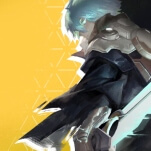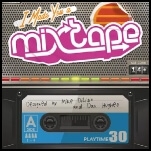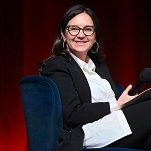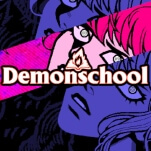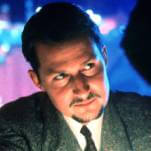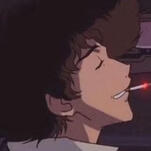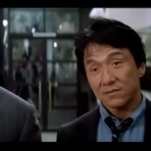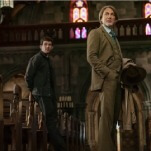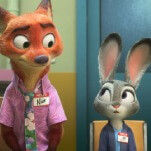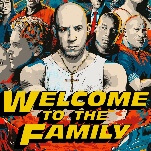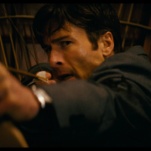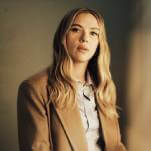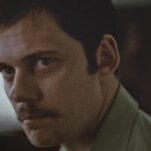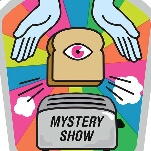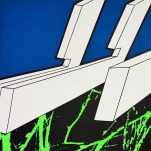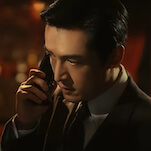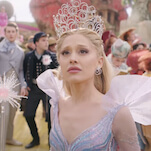A sea of bokeh lights emanates from Tokyo. Light pollution paints the night sky. The camera pans down into the suburbs. The artificial light becomes less dense, clustered along highways and trainlines. Olivia Newton-John’s pop-country fusion recording of “Take Me Home, Country Roads” plays, the gospel-like introduction sung by a choir over organ. Whisper Of The Heart opens unlike any other Studio Ghibli film.
Thirty years since its release, Whisper Of The Heart remains a unique entry in the legendary anime studio’s filmography. It was Ghibli’s first feature directed by someone other than Hayao Miyazaki or Isao Takahata and, while the studio has made some non-fantastical films, none are so mundane nor romantic. Neither have any cemented a legacy like the one left by its director’s single credit. While Miyazaki’s influence as the film’s writer and storyboarder is apparent, Yoshifumi Kondō’s sole directorial effort remains an overlooked but widely influential film.
Both prescient in its subject matter and a direct predecessor to pervasive animation today, Whisper Of The Heart anticipates a current zeitgeist often summed by vague buzzwords: chill vibes and lo-fi aesthetics, Ghibli-esque romantasy, and low-stakes, character-driven plots (all of which are lumped into the expanding anime category of “slice of life”). Even if you haven’t seen moonstruck middle schooler Shizuku Tsukishima fall in love outside of a book for the first time, or follow a cat through the urbanizing expanse of early ’90s western Tokyo, you’ve seen her on YouTube, sitting at a desk overflowing with books, pencil in hand as she writes for hours, lost in the music piped into her wired headphones. Or you’ve seen this same girl dedicatedly working to improve, sitting at her desk day and night as the seasons change around her, in films like Look Back. Or, as in Sound! Euphonium, you’ve watched a young girl, overwhelmed by the passion of her first love, burst into tears when she tries to find her own purpose and fails right away. Even Makoto Shinkai‘s densely packed, tactile background art—popular among anime aesthetes on Instagram—would blend seamlessly into the Tsukishima family’s small apartment.
But these images, removed from their context like the Lofi Girl and her “hip hop radio beats to relax/study to,” are just symptoms of a feeling. Whisper Of The Heart offers a prognosis. More than anything else Miyazaki wrote, Whisper Of The Heart is a love story. His most direct adaptation of a source (Aoi Hiiragi’s 1989 manga), the film maintains the complex characteristics of his child protagonists and its unmagical world sticks its discordant undertones in its characters’ sides like barbs.
At the library during summer break, Shizuku notices a recurring name in the checkout cards of the many books she’s kept her nose in. She forms an ideal of who this “Seiji Amasawa” could be, a romantic image thoroughly shattered by the rude-yet-mysterious boy she finds making violins in an antique shop. Their romance is one of constant refusal of the fairytale stories Shizuku reads at the beginning of the film. Their tropey “school rooftop confession” scene is betrayed by Seiji’s news that he’s leaving to apprentice at a luthier for two months. If he succeeds, he’ll go away again for another 10 years.
Through love, Shizuku finds purpose: writing. She grows from lazily reading all day over summer break to staying up till 3 a.m. writing her novel while Seiji is away. Upon his return, both resolve to push each other towards their goals, even if they part for the foreseeable future. At the same time as he details this love story, Miyazaki works through his feelings on urbanization and the consumer tech boom of the late ’80s. This comes courtesy of a subplot told almost entirely visually. While Shizuku writes by hand, her mom, working on her masters thesis, writes at a chunky folding word processor. Empty fields run along highways. Nighttime landscape shots emphasize artificial lighting. The library is replacing the checkout cards with barcodes, foreclosing on the kind of romantic daydreams Shizuku formed through encountering Seiji’s name. One could even make a drinking game out of how many times people almost get hit by cars.
Confessing her disaffection to all this, Shizuku writes a parody of “Country Roads” for her school choir, titled “Concrete Roads.” While the film itself is nostalgic, Shizuku is not. She’s wary of the future encroaching on her present. This, more than her likeness, is why Shizuku is the Lofi Girl, her analog ideals resisting a current that will make the world less romantic. The cluttered desks and densely packed bookshelves that always accompany her character design—even when detached from Whisper Of The Heart—are the antithesis of a decade of physical minimalism made possible through maximized digital footprints.
While all that is communicated nearly wordlessly in the film, it’s not easily reducible to an aesthetic. Nor is Ghibli’s filmography so reducible as to contain Miyazaki, Takahata, Kondo, and the other directors who have since made films there within a single adjective. At a time when AI image generators attempt to smooth out decades of artistry into a single simplified style, Whisper Of The Heart stands as a resounding refusal of “Ghiblification.”
After Shizuku’s finished the marathon of writing her first novel, she has to accept that it isn’t very good. She’s opened a geode, but the minerals need to be cut and polished. “Now I’ve written it, I know. Wanting isn’t enough. I have to learn more,” she cries after her first failure to extricate something beautiful from within. But Shizuku’s first step isn’t failing to create, it’s succeeding to finally hear the whisper of her heart. Wanting—to be a writer, a luthier, a musician, an animator—isn’t enough. But it’s a start.
Whisper Of The Heart remains singular in part because Yoshifumi Kondō died three years after it was released in Japan. He wouldn’t live to see it come to America; Whisper Of The Heart wouldn’t even be released in English until 2006, after the studio’s global popularity surged in the wake of Miyazaki’s successes in the early ’00s. It’s become a joke how many times Miyazaki has claimed that he would retire, but his first “final film” was Princess Mononoke, Kondō’s last credit as an animation director. Miyazaki had hoped to pass the studio to Kondō, and even held a farewell party after he left Ghibli on January 14, 1998. Kondō died exactly one week later. Two years after Kondō’s death, Miyazaki came out of retirement for the first time, to make the film that would become Spirited Away.
His death, and the films audiences didn’t see from him after Whisper Of The Heart, is perhaps why the aesthetic endures. Kondō never produced his own filmography full of bicycles and folk instruments and cities mid-change. Those that experienced his work wanted more; it wasn’t enough. Unlike the flattening faux-style of Ghiblification, what animators have done with Whisper Of The Heart in the subsequent decades instead looks forward, like Shizuku herself. In her translation of “Country Roads” (back to English), she ditches the rosy images of Appalachia with a feeling more complicated than nostalgia—yearning for something lost, and moving on:
Country road, this old road
Could go right to my home town
I won’t go there, I can’t go there
Can’t go down that country road
Country road, when tomorrow comes
I’ll be like I always am
Want to go back there
Can’t go back there
Fare thee well, country roads


